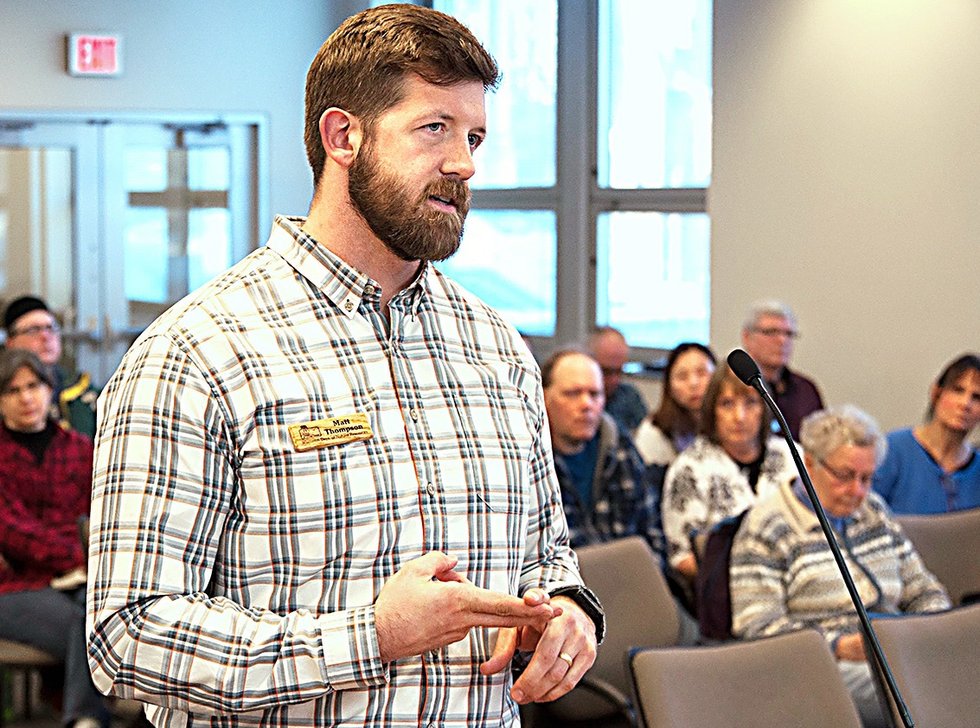(First published in the March 14, 2019 issue of City Pages)
With Thomas Street construction coming soon, residents and city leaders are learning there are no easy answers to the contamination

DNR Hydrogeologist Matt Thompson spoke in Wausau Tuesday about pollution in the Thomas Street corridor. After learning that former occupants on a site there had been burning massive amounts of contaminated wood, the DNR called on site owner Wauleco to put together an investigation plan.
After hearing again from two state toxicologists and now representatives from the DNR, one thing is clear: There won’t be any hard and fast answers on Thomas Street pollution.
That was the general conclusion following two public meetings last Monday regarding pollution on Thomas Street in Wausau and the surrounding neighborhood. Work is set to begin this spring on the second phase of Thomas Street reconstruction, but concerns from residents remain about the environmental impacts of digging up soil for the project.
The city plans to remove the top layer of soil when reconstructing the street, which is expected to cost $3.2 million for the whole project. The city also will have workers wetting the soil to control for dust. Both measures are part of the DNR’s recommendations to mitigate any risk of spreading toxins while reconstructing the street.
But is it 100% safe? That’s something both city leaders and residents want to know, and that’s likely never to be the case, Matt Thompson, DNR hydrogeologist told City Pages following the second of two meetings last Monday.
That would be true of any project that had been remediated. Wausau has plenty of examples of environmentally troubled areas that have been remediated and now have good uses, Thompson pointed out. He points to the Holtz-Krause landfill, now the site of the Eastbay Sports Complex, which hosts sports such as soccer, lacrosse, ultimate Frisbee and the Hmong Festival.
And he points to the Riverlife development, including the park that’s set to be completed in June, as another example of an area with high industrial activity. When dealing with contaminated sites the goal is to minimize risk, Thompson says.
When asked, state toxicologist Clara Jeong told residents Thursday that she would feel comfortable with her grandmother living in the Thomas Street neighborhood. But in what appeared to be confusing to some residents, she also listed safety precautions they should employ that included washing your hands while handling dirt outside and not eating vegetables from a backyard garden.
Also confusing to residents: Jeong says the area is generally safe but also called for further investigation of contamination. The answers are exactly what you would expect from a scientist; but it’s not what reassures residents.
Wausau officials have been considering more tests in the area, which contains one of the biggest PCP plumes (water and soil) in the state, Thompson told City Pages. Members of the group Citizens for a Clean Wausau have been gathering documents and speaking at public meetings, and gaining support on the council for further testing, including in nearby Riverside Park.
After the DNR learned that 400 tons of wood waste per month had once been burned at 910 Cleveland Avenue near Riverside Park and just north of Thomas Street, Thompson says the agency has sent a letter to the site’s current owner, Wauleco, requiring them to put together an investigation plan to find out how contaminated the site is (the area once was home to window manufacturer Crestline and SNE). They will create an aerial model that should reveal where the contamination was likely to have gone and develop a testing plan to confirm the contamination, Thompson says.
Wausau Mayor Robert Mielke told City Pages that the city plans to go forward with the Thomas Street project. After hearing the information from two neutral parties, Mielke believes the contaminated soil can be effectively dealt with. “The city council and city staff have done more to address this matter directly in the last two-and-a-half years, including hearing from and respectfully dealing with the residents from that area, than had ever been done previously before in the past 18 years,” Mielke says.




